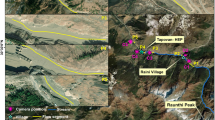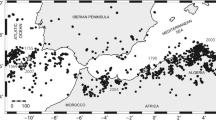Abstract
An earthquake early warning alert system with a high degree of accuracy and precision and measured in seconds is a necessity to save many lives in Japan, one of the most tectonically active countries of the world. In this paper, we estimate the potential value for early warning of crustal and intraslab earthquakes recorded at the KiK-Net network. The work reported here is similar to that of the early warning analysis system of California and uses new comprehensive data from northern and eastern Japan (Hokkaido and Tohoko). An attempt was also made to analyze whether the slopes of the regression lines obtained for Californian events (all are crustal events) are similar to those obtained for Hokkaido and Tohoko crustal events. We also analyzed whether there was any difference between the slopes obtained from Japanese crustal and intraslab earthquakes. The poor correlation of the higher magnitude (>5.5) with predominant period implied quite a limited predictability of predominant frequency. This was evident from the scattered plot obtained for higher magnitudes. These limitations led us to use a discrete wavelet transform-automated algorithm based on the bi-orthogonal construction with two and four vanishing moments for the primal and dual wavelets.









Similar content being viewed by others
References
Allen RM, Kanamori H (2003) The potential for earthquake early warning in southern California. Science 300:786–789
Aoi S, Obara K, Hori S, Kasahara K, Okada Y (2000) New Japanese uphole/downhole strong-motion observation network: KiK-net. Seismol Res Lett 72:239
Cohen A, Daubechies I, Feauveau J (1992) Bi-orthogonal bases of compactly supported wavelets. Comm Pure Appl Math 45:485–560
Daubechies I (1988) Orthonormal bases of compactly supported wavelets. Comm Pure Appl Math 41:909–996
Daubechies I (1990) The wavelet transform time-frequency localization and signal analysis. IEEE Trans Inf Theory 36(5):961–1005
Daubechies I, Sweldens W (1998) Factoring wavelet transforms into lifting steps. J Fourier Anal Appl 4(3):247–269
Horiuchi S, Negishi H, Abe K, Kamimura A, Fujinawa Y (2005) An automatic processing system for broadcasting earthquake alarms. Bull Seism Soc Am 95:708–718
Jensen A, la Cour-Harbo (2001) Ripples in mathematics. Springer, Berlin
Johnstone IM, Silverman BW (1997) Wavelet threshold estimators for data with correlated noise. J R Stat Soc Ser B 59(2):319–351
Kamigaichi O (2004) JMA earthquake early warning. J Jpn Assoc Earthq Eng 4:134–137
Lockman AB, Allen RM (2005) Single-station earthquake characterization for early warning. Bull Seismol Soc Am 95(6):2029–2039
Mallat S (1998) A wavelet tour of signal processing. Academic, San Diego
Mallat S, Zhang Z (1993) Matching pursuits with time-frequency dictionaries. IEEE Trans Signal Process 41:3397–3415
McGuire JJ, Simons FJ, Collins JA (2008) Analysis of seafloor seismograms of the 2003 Tokachi-Oki earthquake sequence for earthquake early warning. Geophys Res Lett 35, L14310
Nakamura Y (1985) Earthquake warning system of Japanese national railways (in Japanese). Railw Technol 42(10):371–376
Odaka T, Ashiya K, Tsukada S, Sato S, Ohtake K, Nozaka D (2003) A new method of quickly estimating epicentral distance and magnitude from a single seismic record. Bull Seism Soc Am 93:526–532
Okaya D, Karageorgi E, McEvilly T, Malin P (1992) Removing vibrator-induced correlation artifacts by filtering in frequency-uncorrelated time space. Geophysics 57:916–926
Olson EL, Allen RM (2005) The deterministic nature of earthquake rupture. Nature 438:212–214
Rioul O, Vetterli M (1991) Wavelets and signal processing. IEEE Signal Proc Mag 11:14–38
Rydelek P, Horiuchi S (2005) Earth science: is earthquake rupture deterministic? Nature 438(7065):212–215
Rydelek P, Wu C, Horiuchi S (2007) Comment on “earthquake magnitude estimation from peak amplitudes of very early seismic signals on strong motion records” by Aldo Zollo, Maria Lancieri, and Stefan Nielsen. Geophys Res Lett 34:L20302
Simons FJ, Dando DE, Allen RM (2006) Automatic detection and rapid determination of earthquake magnitude by wavelet multiscale analysis of the primary arrival. Earth Planet Sci Lett 250(1–2):214–223
Strang G, Nguyen T (1997) Wavelets and filter banks, 2nd edn. Wellesley-Cambridge, Wellesley
Sweldens W (1996) The lifting scheme: a custom-design construction of bi-orthogonal wavelets. Appl Comput Harmon Anal 3(2):186–200
Vaidyanathan P (1993) Multirate systems and filter banks. Prentice Hall
Vetterli M, Cormac H (1992) Wavelets and filter banks: theory and design. IEEE Trans Signal Proc 40:2207–2231
Wu YM, Teng TL (2002) A virtual sub-network approach to earthquake early warning. Bull Seism Soc Am 92:2008–2018
Wu YM, Hsiao NC, Lee WHK, Teng TL, Shin TC (2006a) State of the art and progresses of early warning system in Taiwan. In: Gasparini P, Manfredi G, Zschau J (eds) Seismic early warning, in press. Springer, Berlin
Zollo A, Lancieri M, Nielsen S (2006) Earthquake magnitude estimation from peak amplitudes of very early seismic signals on strong motion records. Geophys Res Lett 33, L23312
Acknowledgments
The authors sincerely thank Frederik J Simons for providing critical insights into the problem as well as several clarifications.
Author information
Authors and Affiliations
Corresponding author
Rights and permissions
About this article
Cite this article
Reddy, R., Nair, R.R. Assessment of earthquake early warning potential from KiK-Net seismograms of 2000–2011 north and east Japan events. Arab J Geosci 8, 3673–3684 (2015). https://doi.org/10.1007/s12517-014-1479-7
Received:
Accepted:
Published:
Issue Date:
DOI: https://doi.org/10.1007/s12517-014-1479-7




